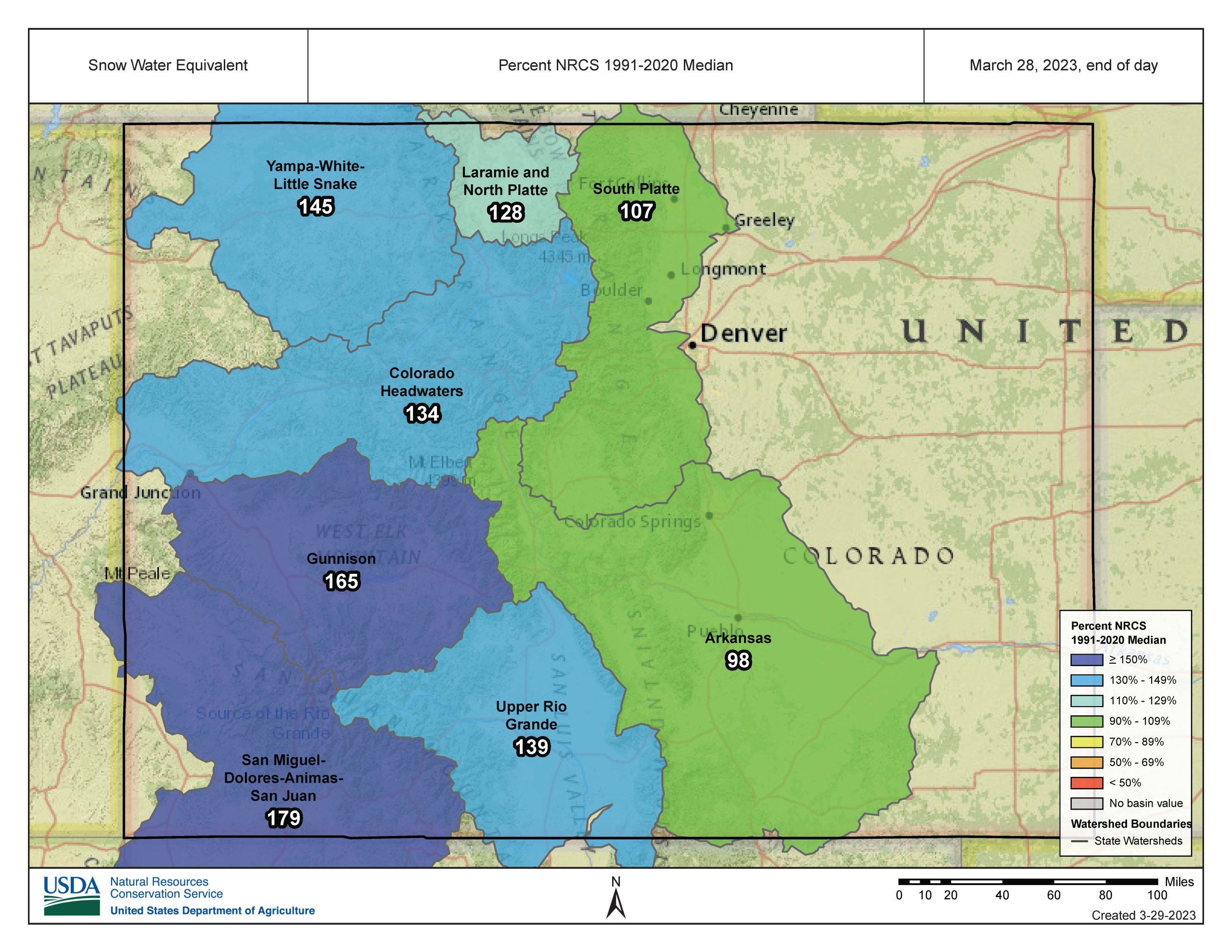Colorado is awash in white this spring, with statewide snowpack topping 140% of average this week, well above the reading a year ago, when it stood at just 97% of normal.
“Conditions in the American West are way better than they were last year at this time,” said state climatologist Russ Schumacher at a joint meeting Tuesday of the state’s Water Availability Task Force and the Governor’s Flood Task Force. “In Colorado we went from drought covering most of the state to most of the state being out of drought.”
Like other western states, mountain snowpacks in Colorado are closely monitored because as they melt in the spring and summer, their runoff delivers much of the state’s water.
A drought considered to be the worst in at least 1,200 years has devastated water supplies across the West. While no one is suggesting the dry spell is over, Colorado water officials said 2023 will likely allow for a significant recovery in reservoirs and soil moisture.

The snow is deepest in the southwestern part of the state, where the San Juan/Dolores river basin is seeing a snowpack of 179% of average.
The Yampa Basin, in the northwest corner of Colorado, is also nearing historic highs, with snowpack registering 145% of average, according to the Natural Resources Conservation Service Snow Survey.
There is considerably less white stuff east of the Continental Divide in the Arkansas River Basin, where snowpack remains slightly below average and in the South Platte Basin, where snowpack is just above average.
The outlook for the seven-state Colorado River Basin has improved dramatically as well, with the U.S. Bureau of Reclamation, in its March 15 report, showing that Lake Powell is likely to see some 10.44 million acre-feet of new water supply by the end of September, or inflows at 109% average.
The Colorado River Basin includes seven states, with Colorado, New Mexico, Utah and Wyoming comprising the Upper Basin and Arizona, California and Nevada making up the lower basin. And it is in the mountains of the Upper Basin, especially in Colorado, where most of the water for the entire system is generated.
That Colorado is seeing such spectacular snow levels this spring, bodes well for everyone. “This is good news for the Colorado River Basin, no doubt about that,” Schumacher said.
Still the drought-strapped Colorado River system will see little storage recovery this year, according to Reclamation, which is forecasting that Lake Powell will see storage at just 32% of capacity by the end of the year. It had dropped to just 23% of capacity last year, prompting ongoing emergency releases from Utah’s Flaming Gorge Reservoir to help keep the system from crashing.
Within Colorado, statewide reservoir storage this month stands at 80% of average, up slightly from this time last year when it registered 75% of average.
Reservoirs within Colorado are expected to see a significant boost in storage levels. Colorado’s largest reservoir, Blue Mesa, was just 36% full earlier this month, but is projected to receive enough new water this year that it will be 71% full by the end of the year, according to Reclamation.
Flood task force officials said the deep snows, particularly in the southwestern and northwestern corners of the state, could cause flooding this spring and summer, especially if there is a series of hot, dry, windy days or major rain storms.
“We are blessed in large part because our snowpack tends to run off in a well-behaved manner,” said Kevin Houck, section chief of watershed and flood protection at the Colorado Water Conservation Board. “But I will say that I am watching things more closely this year. It’s not just the presence of snow that creates our problems. It needs to have a trigger as well. The classic trigger is the late spring warmup. And what can cause even more damage is when we get rain on snow as well.”
Jerd Smith is editor of Fresh Water News. She can be reached at 720-398-6474, via email at jerd@wateredco.org or @jerd_smith.
Fresh Water News is an independent, nonpartisan news initiative of Water Education Colorado. WEco is funded by multiple donors. Our editorial policy and donor list can be viewed at wateredco.org


 Print
Print